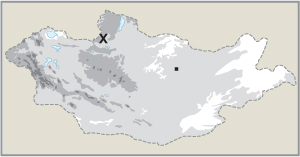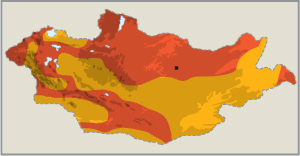
PLATE 52: CUCKOOS
Lesser Cuckoo Cuculus poliocephalus
25 cm

ID Best distinguished from similar Common and Oriental Cuckoos by size (almost one-third smaller) and by finer bill. Voice Male’s territorial call is an emphatic six-note whistle: we-choo-tee-we-choo-tee. Habitat Forest. Behaviour A brood parasite of Cettia warblers. Status Vagrant. One in Delgermörön River valley, Hövsgöl province, August 1995.
Indian Cuckoo Cuculus micropterus
32–33 cm

ID Distinguished from very similar Common and Oriental Cuckoos by darker grey back; broader more widely spaced barring below; and black terminal band and more extensive white speckling on tail. Voice Male’s territorial song is a repetitive, mellow, four-syllable phrase with emphasis on third note, often rendered as ‘one more bottle’. Habitat Well-wooded country. Behaviour Elusive. A brood parasite of drongos. Status Vagrant. One in Nömrög River valley, Dornod province, 6 June 1995.
Oriental Cuckoo Cuculus optatus
30–34 cm

ID Generally not distinguishable by plumage in the field from Common Cuckoo, which see for subtle distinctions. Voice Male gives a pu-pu-pu-pu-pu-pu…song very similar to that of Eurasian Hoopoe, with which it widely co-occurs, and very unlike Common Cuckoo’s cuoo-ku. Habitat Coniferous, deciduous and mixed forest in Mongol-Altai, Hövsgöl, Khangai and Hentii mountain ranges. Also occurs in arid steppe on migration. Behaviour As Common Cuckoo; parasitises Phylloscopus warblers. Status Uncommon breeding visitor and fairly common passage migrant, late April to late August. Taxonomy Formerly treated as C. saturatus when united with extralimital Himalayan Cuckoo.
Common Cuckoo Cuculus canorus
32–36 cm

ID Virtually identical to Oriental Cuckoo, though the latter typically has heavier black barring above and below in both grey and rufous morphs, and has yellowish (vs. white) undertail-coverts. However, these characters are variable and hard to discern in the field and the two species are best distinguished by song. Voice Male constantly repeats familiar cuckoo clock cuoo-ku song – very different from Oriental Cuckoo’s monotone pu-pu-pu-pu-pu.... Female has bubbling call. Habitat Coniferous, deciduous and mixed forests and woodlands. Occurs in almost all habitats on migration. Behaviour A brood parasite that lays its eggs in nests of small songbirds such as warblers, accentors and pipits, which rear the cuckoo’s young at expense of their own. Status Fairly common breeding visitor in Hövsgöl, Khangal and Hentii mountain ranges and passage migrant throughout, late April to late August. [Alt: Eurasian Cuckoo]